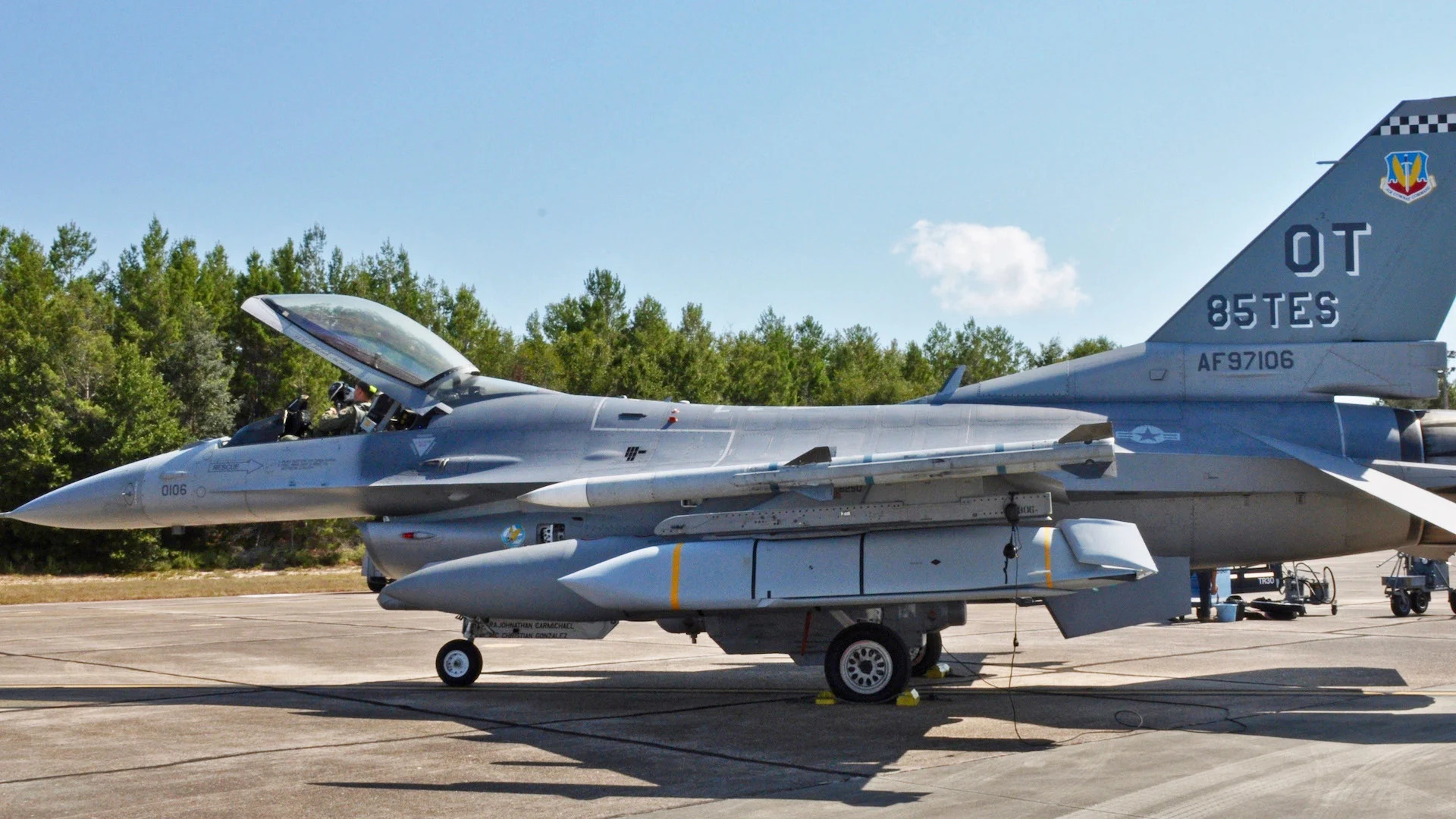Biden ‘open’ to sending long-range cruise missiles to Ukraine

The Biden administration is “open” to sending long-range cruise missiles to Ukraine, a move that would give Kyiv’s F-16s greater combat punch as it seeks to gain further momentum in its fight against Russia.
The White House’s willingness to give Ukraine the Joint Air-to-Surface Standoff Missile comes as Kyiv’s surprisingly successful ground assault deep inside Russia heads into its second week, embarrassing Vladimir Putin and forcing him to redirect troops from the battlefield in Ukraine.
No final decision has been made on sending the missile, but the administration is working through the complicated details now, according to one Biden administration official. Those issues include reviews of the transfer of sensitive technologies, and ensuring Ukraine’s jets can launch the 2,400-pound missile that carries a 1,000-pound warhead.
The official, along with two other people familiar with internal deliberations, was granted anonymity to discuss sensitive issues.
The Pentagon declined to comment on whether it had approved the transfer of the missile.
“We consider a range of options to meet Ukraine’s security assistance requirements, however we have no information to provide,” said Pentagon spokesperson Jeff Jurgensen.
The debate surrounding the JASSM and the Biden administration’s willingness to explore its transfer makes the missile the latest in a long line of sophisticated weaponry once considered off-limits for transfer to Ukraine.
AfriPrime App link: FREE to download...
https://www.amazon.com/Africircle-AfriPrime/dp/B0D2M3F2JT
Some members of Congress and political opponents have accused the Biden administration of moving too slowly to give Kyiv the equipment it needs to win the war. Yet for a conflict that is just 30 months old, the approvals of F-16s, Abrams tanks, cruise missiles, Patriot air defenses and modern infantry carriers have transformed what was a Soviet-era military into one of Europe’s battlefield powerhouses.
The potential move comes in the waning months of President Joe Biden’s tenure, after which the level of U.S. support for Ukraine becomes less clear if former President Donald Trump retakes the White House.
The air-launched missiles would give the Ukrainian air force a capability only a handful of other nations have: launching a cruise missile over 200 miles from a U.S.-made fourth-generation fighter plane.
While talks continue inside the White House and Pentagon, the administration official warned that there is plenty of work to do before any missiles actually make their way to Ukraine, including making sure that Kyiv’s existing Soviet-era planes and its freshly delivered F-16s can launch the missile at targets over 230 miles away.
The Pentagon is already working with Ukraine on those technical issues, two of the people said.
The JASSM, developed by Lockheed Martin and first fielded in the early 2000s, has been used by the U.S. sparingly in combat and has been shared with only a handful of close allies.
Ukraine already possesses both air and ground-launched missiles provided by the U.S., U.K. and France that can reach almost 200 miles from their launch point, but restrictions on the missiles’ use inside Russia are for now staying in place.
The limitations, which stipulate that Ukraine can’t use U.S.-supplied weapons inside Russia unless it’s just over the border and for self-defense only, have frustrated Kyiv, which has repeatedly asked for a freer hand to strike Russian forces inside their country. It may be too late anyway for Ukraine to use its existing missiles to strike Russian aircraft at their bases, as the Russian military moved their fighters beyond the range of those missiles in May, according to the administration official.
As Ukraine pleads for the U.S. to relax its rules, Moscow has used its fighter planes flying safely inside Russia to launch glide bombs at Ukrainian cities, killing civilians.
Ukrainian parliamentarians and advisers to President Volodymyr Zelenskyy have over the last several months pressed Biden officials and lawmakers on Capitol Hill to send the JASSM. That pressure grew when a cohort of Ukrainian parliamentarians visited Washington in July. Their request made its way to national security adviser Jake Sullivan, one of the people said.
Poland, Australia and Finland have the weapon, while Japan and the Netherlands signed agreements to buy the missiles in July with delivery expected in the coming years. Germany, Greece, Romania and Denmark are also in discussions to buy the missile.
Missile maker Lockheed Martin has delivered over 4,100 JASSMs in various configurations to the U.S. Air Force and allies over the years, with a new production line in Alabama churning out around 45 missiles a month to reach a stockpile goal of 7,200 missiles, according to Pentagon data.
The JASSMs would give Ukraine a significant boost in range, as the F-16s donated this summer by European countries are not expected to fly close to Russian lines for fear of being shot down.
The U.S. and allies have already committed to sending Ukraine a variety of air-to-air and air-to-ground munitions for its F-16s, but the JASSM deliveries would give Kyiv the most powerful and longest-range weapon in its air force’s arsenal.
A cadre of pro-Ukraine U.S. lawmakers has been pressing the administration to loosen restrictions on Kyiv’s ability to fire U.S.-supplied weapons into Russian territory. They argue that the U.S. should keep the momentum going after Ukrainian forces crossed the border into Russia on Aug. 6.
“Certainly we are pushing for additional weapon systems to be supplied to the Ukrainians because the Russian aerial reign of terror has reached a different order of magnitude — maybe several orders of magnitude greater than it was, with different kinds of missiles, glide bombs and drones,” said Sen. Richard Blumenthal (D-Conn.), who returned Tuesday night from Kyiv. Blumenthal declined to comment on any specific weapons under discussion.
The Pentagon has been receptive to the suggestion from Congress to supply the missiles because Russia has been successful at jamming some other American-made, precision-guided weapons.
Joint Chiefs Chair Gen. C.Q. Brown didn’t rule out sending the missiles when Ukraine Caucus Co-Chair Rep. Joe Wilson (R-S.C.) asked at a hearing in April whether the Defense Department was considering the action. How the F-16s would be armed would be part of DOD’s talks with Ukraine Defense Contact Group allies, Brown said.
“As we bring on the F-16s, it’s not only the airplanes, but the training of the pilots, the training of the maintainers — but also making sure we have the weapons to go with it,” Brown said. “That is the dialogue we’re having not only to get the airplanes but to get them to full capability.”
AfriPrime App link: FREE to download...
https://www.amazon.com/Africircle-AfriPrime/dp/B0D2M3F2JT
JASSM Stealth Cruise Missiles Now On The Table For Ukraine
An F-16 Fighting Falcon piloted by Lt. Col. Mike May from the 85th Test and Evaluation squadron sits on the ramp at Eglin Air Force Base on October 2, 2019 with a JASSM-ER. The 85th TES released the extended range missile as part of an operational test sortie.
The United States is reportedly “open” to providing Ukraine with the AGM-158 Joint Air-to-Surface Standoff Missile or JASSM, to arm its newly arrived F-16s, and which would provide a very powerful new long-range strike capability. The reports from Washington come around six months after Ukrainian officials stated that the country would receive an undisclosed type of air-launched cruise missile with a range of up to 300 miles for its F-16s.
Citing an unnamed official in the Biden administration, as well as two other people “familiar with internal deliberations,” Politico reported today that the U.S. government is considering whether to approve JASSM for Ukraine, but is open to the idea. Furthermore, the same sources confirm that the Pentagon is already working on how to integrate these missiles on Ukraine’s F-16s, which are upgraded older-model jets drawn from European NATO stocks.

U.S. Air Force photo by Staff Sgt. Brandi Hansen
The jets being supplied to Ukraine are to the F-16AM/BM standard, which has undergone the Mid-Life Update (MLU) program, although none of these currently employ JASSM. The only F-16 operators that today use the missile are the U.S. Air Force and Poland, operating more modern versions of the aircraft. It is likely the case that the MLU jets can accept the software needed to use JASSM, or already have it, but this may require activation or some associated hardware tweaks, which would probably be limited.
Although a final decision is reportedly yet to be made, the same Biden administration official states that the details of the transfer — including how to address the missile’s sensitive technologies — are now being worked out.
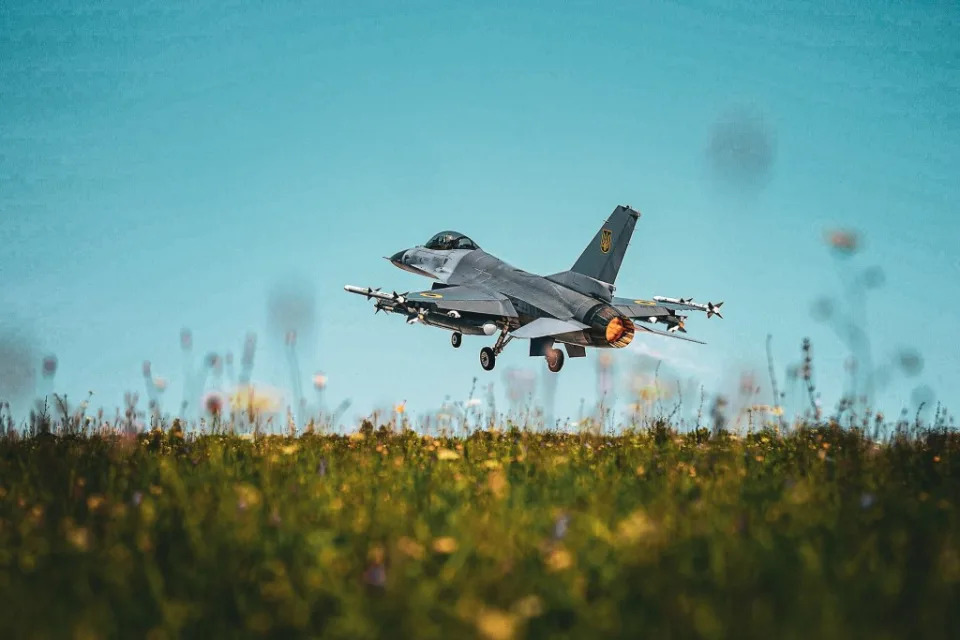
Although in service for some 20 years and already integrated on some F-16s, among other combat aircraft, JASSM is very much a high-end weapon and one that had, until now, been widely seen as less likely to be provided to Ukraine.
When the idea of transferring F-16s to Ukraine became a reality, we examined the weapons likely to be included, and judged that the JASSM was “the biggest wild card of them all.” This is on account of its complex and classified technologies, not least of which is its low-observable (stealth) characteristics that make it highly survivable, even against the latest air defense systems.
Transferring these weapons to Ukraine involves considerable technological risk, but it appears that officials are now very much considering whether that risk is worthwhile.
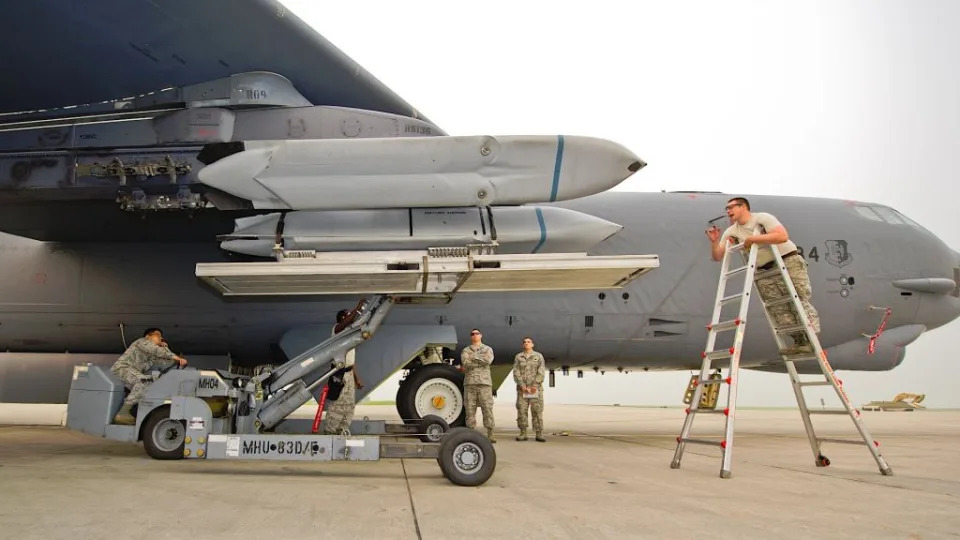
www.twz.com
As well as the possibility of JASSMs, or their wreckage, ending up in Russian hands, there’s also the issue of the missile’s relatively very long range.
In its initial AGM-158A form, the JASSM has a range of around 330 miles and weighs 2,250 pounds. The extended-range AGM-158B variant, or JASSM-ER, has a publicly stated range of at least 575 miles. An even longer-range version of the JASSM is in the works, but this has not been fielded yet by the U.S. military.
Powered by a small turbojet engine, JASSM uses an inertial navigation system (INS) and GPS to find its intended target, with an imaging infrared with automatic target recognition used to ensure a high level of accuracy on the run-in to the target. The missile is designed to operate in heavily degraded GPS environments, which would be particularly relevant in Ukraine, where Russia employs intense GPS jamming, including to degrade Ukrainian-guided weapons. JASSM carries a dual-mode blast-fragmentation/penetrator warhead in the 1,000-pound class.

Were the United States to provide Ukraine with JASSM, there would be a big question as to whether it would be permitted for use against targets within Russia’s borders. That question is thrown into sharper focus by the Ukrainian push into Russia’s Kursk region, which is now entering its second week.
For missions inside Ukraine’s borders, the weapon’s range is far in excess of the country’s needs, although this could potentially be altered to address this.
AfriPrime App link: FREE to download...
https://www.amazon.com/Africircle-AfriPrime/dp/B0D2M3F2JT
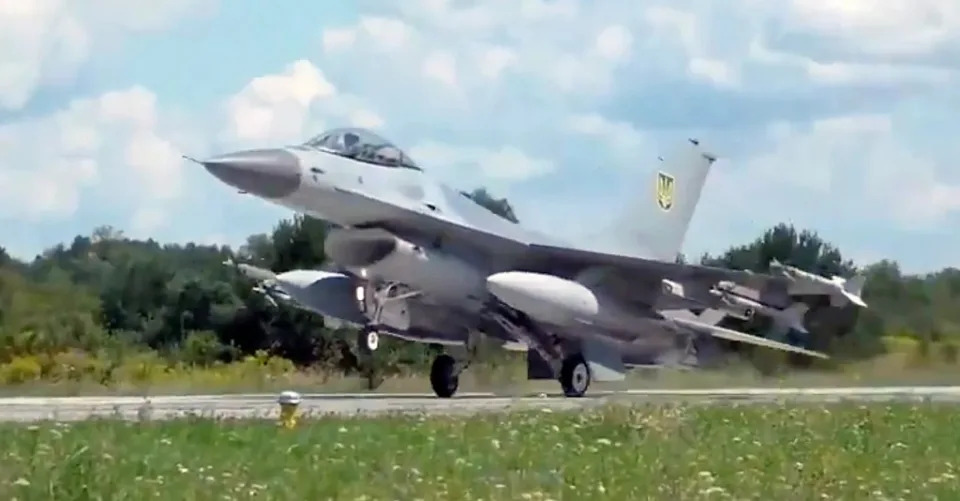
While Western sources have generally discounted the possibility of supplying JASSM to Ukraine, officials in that country have struck a more optimistic tone.
Back in February, Lt. Gen. Serhii Naev, the commander of the Joint Forces of the Armed Forces of Ukraine, said that the country’s F-16s would receive an undisclosed type of air-launched cruise missile with a range of “300-500 kilometers” — 186 to 310 miles. Naev added that the weapons were expected to arrive in “further military aid packages,” but provided no more details. As we explored at the time, JASSM seemed to be the most likely candidate, based on this description.
Last month, a Ukrainian delegation visited Washington, reportedly with a specific request to approve the transfer of JASSM. That visit is said to have led to the issue reaching the desk of National Security Adviser Jake Sullivan.
Meanwhile, in some U.S. political circles, there is growing support for giving Ukraine longer-range weapons and relaxing restrictions on their use.

Twitter screencap
For example, a group of pro-Ukraine U.S. lawmakers is calling upon the administration to permit Ukraine to launch U.S.-supplied weapons deeper into Russian territory, especially in support of the new Kursk offensive.
Should Washington be poised to hand JASSM over to Ukraine, the missile, even if supplied in its oldest form, would be a huge leap in capability for the country. In particular, it would be especially effective for deeply penetrating the dense Russian air defense overlay that sits atop occupied territories in Ukraine.
It would also not be the first time that an item of high-end weaponry was provided to Ukraine after a policy about-turn. That applies to the U.S.-supplied M1 Abrams tanks, Patriot air defense systems, and the Army Tactical Missile Systems (ATACMS), as well as the F-16 itself.
Meanwhile, other long-range cruise missiles have been delivered to Ukraine already, namely the U.K.-supplied Storm Shadow, and the similar French-supplied SCALP EG cruise missiles. Both have already been used to significant effect, launched by Ukrainian Su-24 Fencer strike aircraft, although stocks are limited and the JASSM may well also be required simply to keep the Ukrainian Air Force stocked with cruise missiles.
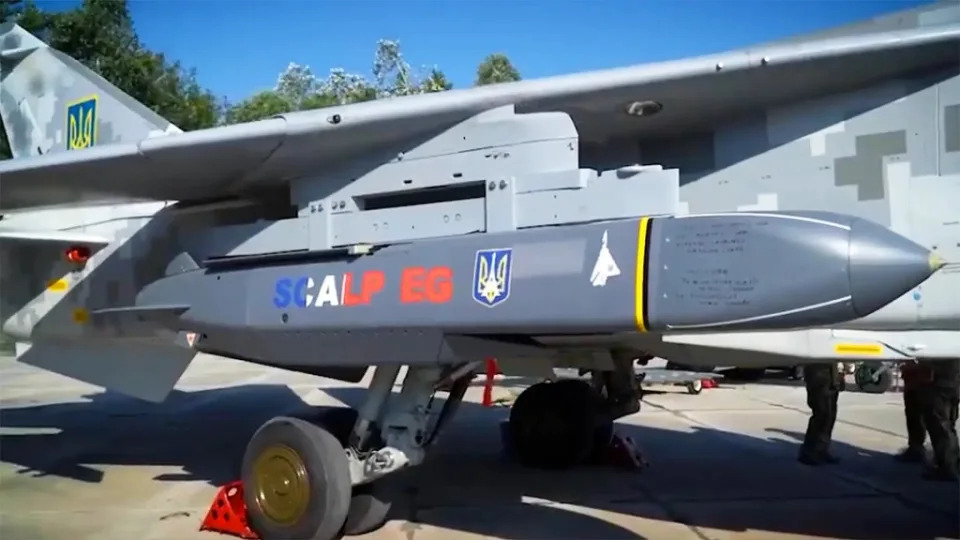
A Ukrainian Su-24 carrying a SCALP-EG cruise missile. Ukrainian Ministry of Defense
The Storm Shadow/SCALP-EG export configurations have a range of around 155 miles, while the non-export configurations are roughly double that, putting them in broadly the same class as JASSM. Neither of those European-supplied cruise missiles is currently permitted for use against targets deep within Russia.
There is also the question of how long it would take to get JASSM operational with the Ukrainian Air Force’s newly arrived F-16s. While reports suggest that studies, at least, into the integration of this missile onto Ukrainian F-16s are already underway, it would also take some significant time for pilots and maintainers to be trained to use it. At the same time, JASSM requires a significant backend infrastructure for planning missions, which in turn requires weaponeering training. Mission planning is a critical factor for JASSM, with the latest threat information needed to give it the best chance of surviving as it flies through a heavily defended area.
So far, Ukrainian F-16s have only been seen with air-to-air load-outs, with the likelihood that air defense missions will be mastered first, before adding offensive capabilities.
With Ukraine long having sought weapons with more reach, to attack high-value Russian targets like air defense systems, command posts, logistic storage sites, air defenses, and docked vessels, JASSM would be a welcome addition to its armory, as it seeks to target objectives further from the front lines.
It’s unclear at this point if Washington will decide to provide Ukraine with AGM-158s, but today’s reports are, at the very least, the strongest indication yet that the issue is very much under discussion, and JASSM-armed Ukrainian F-16s are becoming closer to reality.
AfriPrime App link: FREE to download...
- Questions and Answers
- Opinion
- Story/Motivational/Inspiring
- Technology
- Art
- Causes
- Crafts
- Dance
- Drinks
- Film/Movie
- Fitness
- Food
- Juegos
- Gardening
- Health
- Home
- Literature
- Music
- Networking
- Other
- Party
- Religion
- Shopping
- Sports
- Theater
- Wellness
- News
- Culture
- War machines and policy


